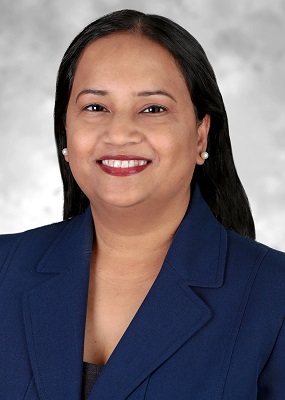Dr. Subhashini Ayloo, section chief of Brown Surgical Associates’ hepatobiliary and pancreatic surgery division, specializes in minimally invasive surgery, liver transplants and surgery on the liver, biliary system and pancreas.
Ayloo explains how minimally invasive surgical techniques have changed and are continuing to change her areas of specialty.
PBN: In addition to your surgical fellowships, you’ve earned a master’s in public health from the University of Illinois at Chicago. How does your background in that field influence your approach to medicine?
AYLOO: This is an important question, having the knowledge and skills gained from a master’s in public health empowers surgeons to translate their work at individual clinical levels to societal echelons. This brings forth innovation and improvement in patient population outcomes, and the creation of efficacious health systems and policies.
PBN: Please briefly explain your areas of clinical focus and the minimally invasive surgical techniques that you are able to employ for patients with complex conditions.
AYLOO: My area of focus is in hepatobiliary and pancreatic surgery, which deals with health issues relating to liver, bile ducts and pancreas. Prior to training in HPB, I trained in minimally invasive surgery. I practiced this for over a decade and am now able to expertly combine my knowledge and transfer the MIS experience to HPB operations. It is a unanimous finding that any operations performed in an MIS technique has better patient outcomes.
PBN: How is the robotic surgery that you perform different from the way similar procedures were done in the past, and how different is the patient’s experience?
AYLOO: Operations relating to this field are predominantly dealt with in an open surgical approach. While several other specialties in surgery have moved on to minimally invasive surgery, HPB/transplantation operations are mostly conducted in an open approach because of their complexity and association with significant morbidity and mortality. These operations can be quite complex in nature due to the anatomy and possible variations, fragility of the organs, proximity to major blood vessels and critical structures. Despite this, when performed well with an MIS approach, both the short- and long-term patient outcomes are superior.
Computer-assisted platforms offer better ergonomics, visibility, stability and, most importantly, the smooth integration of other systems such as radiological, ultrasonographic, fluorescence imaging. These all aid in the surgeon’s ability to perform meticulous operations.
PBN: Are there any procedures within your specialty that have recently become possible with the help of robotic technology?
AYLOO: Worldwide we are at the early stages of performing these operations with feasibility and safety, while studying the outcomes. It is a matter of time before these procedures will be simplified and standardized.
PBN: You are known as an innovator in minimally invasive surgery. What’s next in this field as it relates to transplants and HPB cancers?
AYLOO: Small steps of innovation in MIS-HPB with time will add up to a giant leap in superior patient outcomes. As I have stated, the MIS approach often leads to less blood loss, a shorter stay in the hospital and return to normalcy faster. With time, these outcomes will only improve.
Consider a day when patients have less pain from these procedures and therefore require less pain medications because they do not have a large, open incision underneath their rib cage. An MIS approach will also mean fewer wound complications like infections, hernias, readmissions and reoperations. Better yet, with experience, surgeons will be able to safely and effectively extend surgical indications with the use of integrated systems that will help to remove tumors in an even less-invasive way. Consider the lives that will be saved!
Because of the built-in simulation and integration of ancillary systems within the computer-assisted platforms, it is conceivable for surgeons to rehearse the procedure exactly in the anatomical milieu of their actual patient prior to the real operation.
The field is wide open to explore and soon this experience will be passed on to the next generation of surgical trainees. For them it will no longer be an innovation to perform operations on the liver, bile ducts and pancreas with a minimally invasive approach – this will be the norm.
Elizabeth Graham is a PBN contributing writer.













